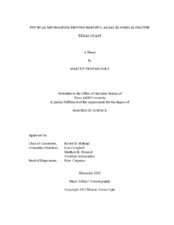| dc.description.abstract | Commonly referred to as “red tide”, harmful algal blooms (HABs) formed by Karenia brevis occur frequently in the Gulf of Mexico (GOM). A bloom is defined as cell abundances >105 cells L-1. This thesis will focus primarily on Karenia brevis, formerly known as Gymnodinium breve, in the Gulf of Mexico. K. brevis is harmful because it produces brevetoxin, a ladder-frame polyether that acts as a potent neurotoxin in vertebrates. K. brevis commonly causes fish kills, respiratory irritation in humans, and Neurotoxic Shellfish Poisoning (NSP) if ingested. Blooms of K. brevis occur almost annually along the West Florida Shelf (WFS) in the late summer and early fall, when the coastal current is favorable for bloom initiation. Along the Texas-Louisiana shelf (TLS) however, blooms of K. brevis are infrequent and sporadic.
While much is known of the blooms along the WFS due to their frequent presence, little is known of the mechanisms driving the blooms along the TLS due to their inconsistent presence. To understand the stochastic nature of HABs along the TLS, historical data of bloom occurrences from 1996 to present were compared with NOAA station PTAT2 wind, sea-level pressure, air and water temperature data and NCEP NARR-A sea-level pressure data. The difference in the monthly-mean along-shore component of the wind was statistically significant between bloom and non-bloom years in September (p<<0.001) and April (p=0.0015), with bloom years having a strong downcoast current. Monthly mean water temperature values yielded similar results between bloom and non-bloom years. Both March and September monthly-mean water temperature values were lower during non-bloom years with p-values of 0.01 and 0.048, respectively. These results suggest the possibly of forecasting for HABs along the TLS with currently measured, publicly available data. | en |


